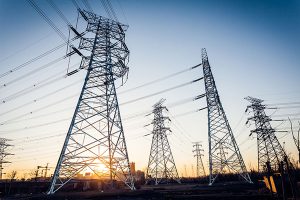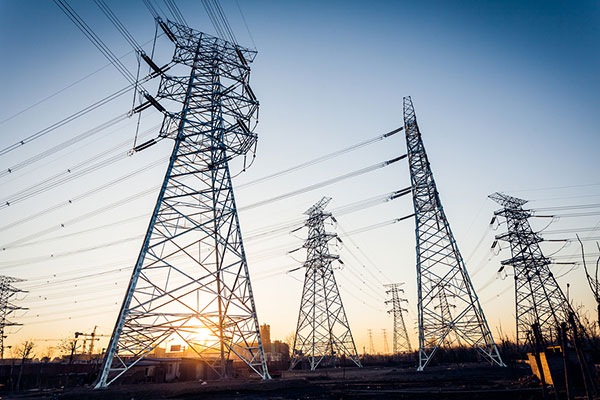Power cables commonly used methods are mostly divided into underground direct burial or overhead, which is the common overhead cable in our daily life.
Overhead lines mainly refer to overhead open wires, erected above the ground, which are the use of insulators to fix the transmission wires upright on the ground on the tower to transmit power transmission lines.
Erection and maintenance are more convenient and less costly, but they are susceptible to meteorological and environmental influences that can cause failures.
At the same time, the whole transmission corridor occupies more land area and is prone to electromagnetic interference in the surrounding environment.
What is the Overhead Cable?
Overhead cable, the full name of overhead insulated cable, is an overhead conductor equipped with an insulating layer and a protective sheath.
It adopts a special cable similar to the production process of cross-linked cable, which is a new power transmission method between overhead wires and underground cables.
Overhead cables are single-core, their structure can be divided into hard aluminum wire structure, hard drawn copper wire structure, aluminum alloy wire structure, steel or aluminum alloy core support structure, and self-supporting three-core tattoo structure.
The core of the wire can be hard aluminum or hard copper wire.

Overhead Line Failure
Causing conductor short circuits and damage
① Conductor line distance is small, and three-phase conductor perpendicularity is different, encountering gusts of wind, easily triggered by phase-to-phase short-circuit, and burns the conductor.
② Branches, metal objects falling on the line.
Crane operation accidentally touches the line, will also cause conductor short circuit and damage.
③ The long-term corrosion of the surrounding environment by harmful gases, the effective cross-section is reduced.
Conductor damage is not very serious and can be used as appropriate to repair the method of laying the line to give treatment.
Conductor Joints Overheating
① Conductor load current exceeds the maximum allowable value of the conductor cross-section.
② Poor quality of construction work of the wire joints.
③ Line for a long time from the wind and rain, oxidation corrosion is becoming increasingly serious, and the joint contact resistance becomes larger, affecting the heat. Once found that the conductor overheating, you can try to reduce the load, continue to monitor the operation, and according to the development of arrangements for processing.
Cable Line Failure
As far as the phenomenon is concerned, the cable failure contains mechanical damage, lead skin (aluminum skin) cracking, cracking, terminal head contamination, terminal head or intermediate joints’ explosion, insulation breakdown, corrosion holes in the metal sheath, and other faults.
As far as the cause is concerned, the cable failure contains external damage, chemical corrosion or galvanic corrosion, lightning, flooding, insect pest construction improper maintenance, and other failures.
Plastic Cable Water
Because once the plastic is invaded by water, it is easy to occur insulation the aging phenomenon.
Especially when the conductor temperature is high, the moisture in the conductor caused by the penetration of the aging is more serious.
So the transportation, storage, laying, and operation of plastic cables are not allowed to enter the water.
Cable Overload Operation
The safety of cable operation has a close relationship with its load capacity.
Overloading will increase the accident rate of the cable, but also shorten the service life of the cable.
Cable damage caused by overloading is mainly in the following aspects:
① Causing damage to the conductor contacts.
② Accelerate the aging of cable protective insulation.
③ Make the cable lead package expansion, and even cracking phenomena, such as poor manufacturing quality, and poor installation conditions of the cable under long-term overload will be caused by the lead package fatigue, cracking, and cracking phenomenon. The cable terminal head will be swollen and cracked by the expansion of asphalt insulation rubber.
Damaged by External Forces
Cable itself, a considerable part of the accident, is caused by external mechanical damage.
According to statistics by the municipal construction management is lax, poor construction caused by external mechanical damage, accounting for about 50% of the cable accident.
So in cable transportation, lifting, and laying through the building, pay special attention to prevent the impact of external forces.
When constructing near the cable line, construction workers should be prompted to pay special attention to this point and, if necessary, take protective measures.
① Pollution of Cable Terminal Head Casing
The main measures are to regularly clean the casing, preferably under blackout conditions for thorough cleaning: in areas of serious filth, the cable terminal head casing is to be coated with antifouling paint, or an appropriate increase in the insulation level of the casing.
② Outdoor Terminal Head into the Water Explosion
Mainly due to improper construction and maintenance, resulting in the terminal head of condensed water agglomeration in the cable head, ultimately leading to moisture breakdown of insulation, causing an explosion.
③ Cable Intermediate Joint Explosion
The mostly overloaded joint box is caused by the expansion of the insulating rubber and cracked shell, or the conductor connection is poor, so the joints overheat and explode.
Although the overhead cable brings great convenience to our lives, there are also many uncontrollable factors.
The quality of power cables directly affects the operation of the line safety, once the line can not be safe and stable operation, its failure to cause life and economic losses can not be predicted.
Therefore, we need to fundamentally prevent the occurrence of cable failures, minimize cable accidents, start from the smallest point, and strive to achieve the goal of a safe and stable power supply.
Prevention of Overhead Cable Failure
1 Make a good short-circuit current calculation, and correctly select and calibrate the electrical equipment, so that the rated voltage of the electrical equipment and the rated voltage of the line are in line.
2 Correctly select the setting value of the relay protection and the rated current of the fuse, the use of fast-break protection devices.
So that when a short circuit occurs, it can quickly cut off the short-circuit current, reduce the duration of the short-circuit current, and minimize the loss caused by the short circuit.
3 Installation of lightning rods at substations and lightning arrestors near transformers and on lines to reduce lightning damage.
4 Use reactors to increase system impedance and limit short-circuit current.
5 Remove faulty lines or equipment from the power system so that the rest can continue to operate.
6 Prohibit pulling the knife gate with load and closing the grounding knife gate with electricity.
The grounding wire should be removed immediately after line construction is completed. And regular inspection of the line and its equipment to check found problems and failures, prompt overhaul, and maintenance.
7 To ensure the construction quality of overhead cable lines, strengthen line maintenance, and always keep the line arc sag consistent and attached to the regulations.
8 Charged installation and maintenance of electrical equipment, to prevent miswiring, misoperation, working close to the charged parts, to take measures to prevent short-circuit.
9 Strengthen management to prevent small animals from entering the distribution room and climbing on the electrical equipment.
To clean up the adsorbed dust on the line promptly, to avoid dust running into the electrical equipment, and to ensure that the line is clean and tidy. For more cable product knowledge, please consult the ZMS cable website.

